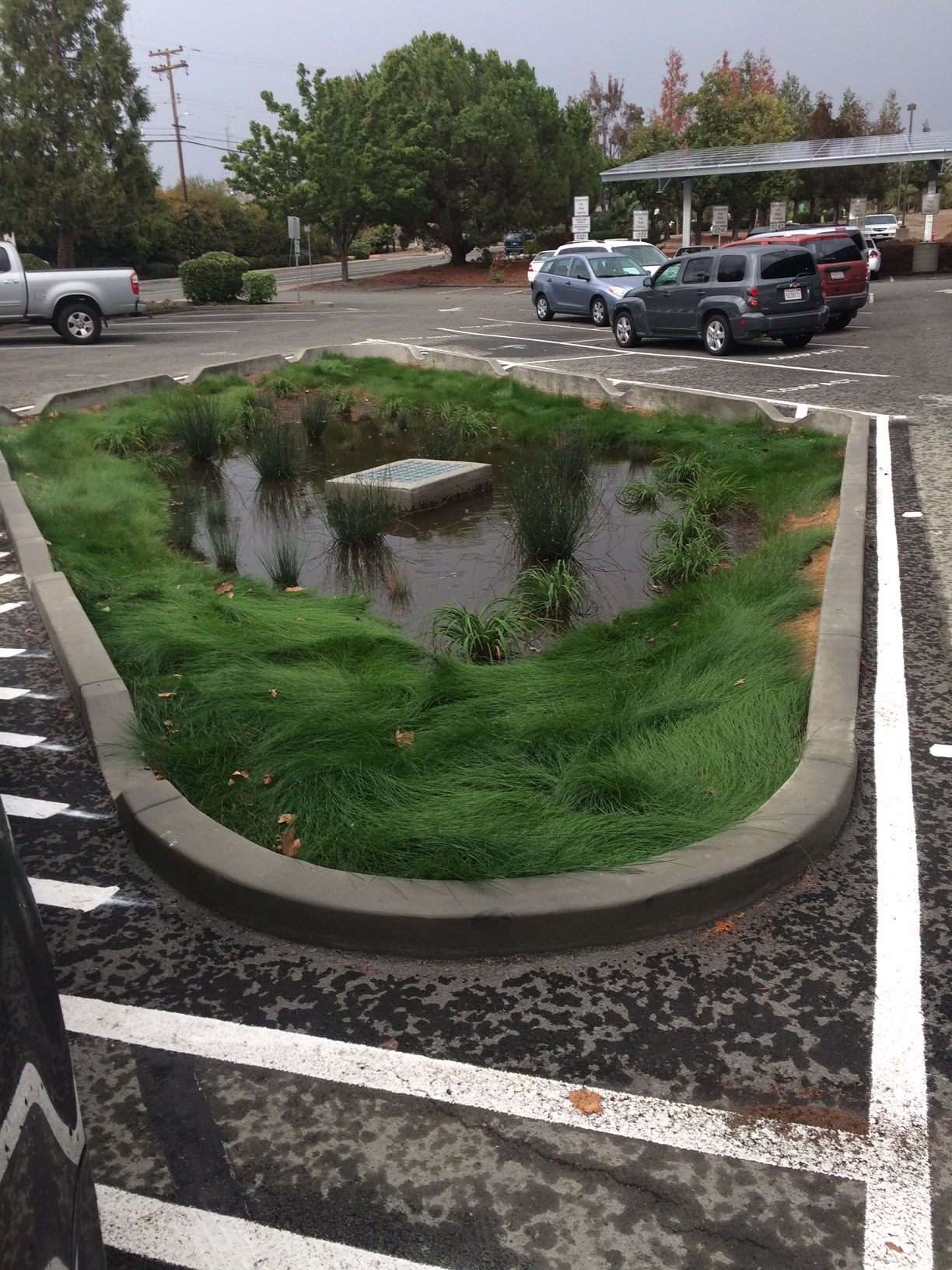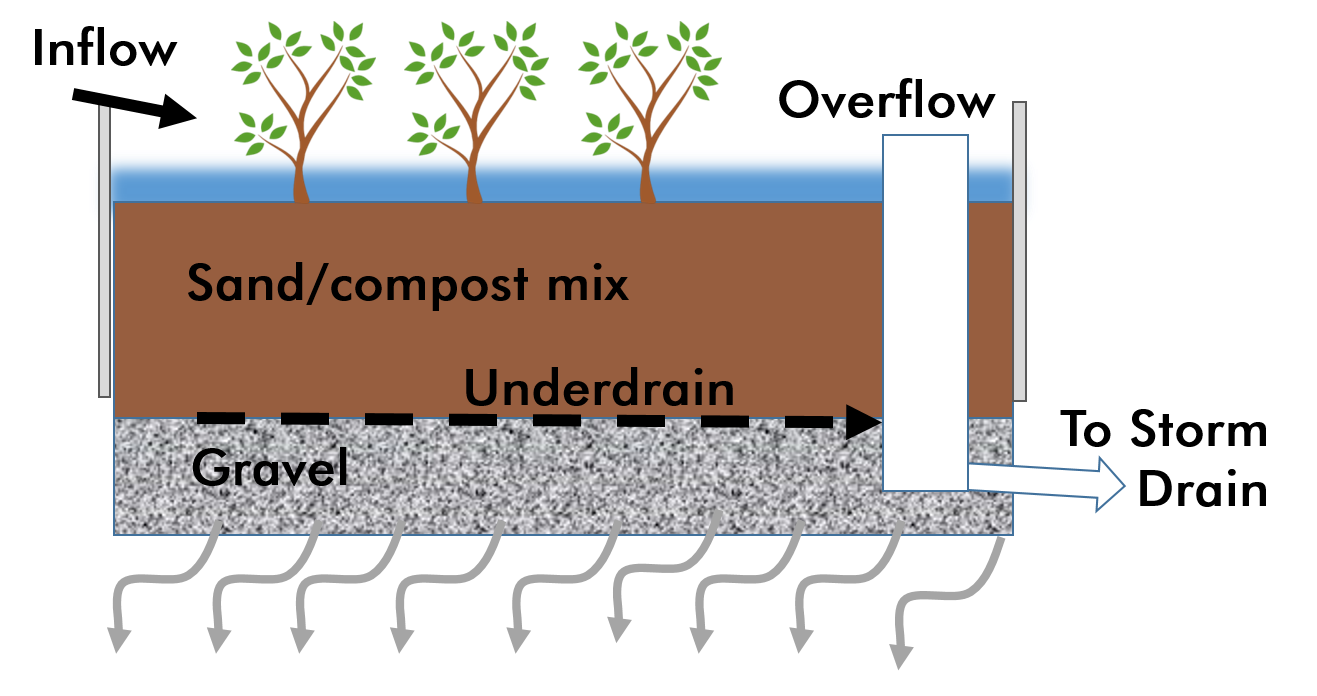Green Infrastructure
What Is Green Infrastructure?
Green Infrastructure Requirements
Municipal Regional Stormwater Permit Provision C.3.j. requires municipalities to complete and implement a Green Infrastructure Plan for the inclusion of Low Impact Development drainage design into storm drain infrastructure.
Each Green Infrastructure Plan describes how, over the long term, the municipality will shift their streets, roads, storm drains, parking lots, and building roofs from conventional “gray” storm drain infrastructure—where runoff flows directly into storm drains and then to creeks and the Bay/Delta—to a more resilient, sustainable system that slows runoff by dispersing it to vegetated areas, promotes infiltration, and uses bioretention to clean runoff.
The municipalities’ Green Infrastructure Plans were submitted to the San Francisco Bay Regional Water Quality Control Board in September 2019.
 Some Frequently Asked Questions about Green Infrastructure
Some Frequently Asked Questions about Green Infrastructure
What are the types of Green Infrastructure facilities, and where will these facilities be located?
“Green Infrastructure” includes facilities built on private land, often as a condition of approval for development or redevelopment, as well as retrofits to public parking lots and streets. Most public retrofit Green Infrastructure facilities will be bioretention facilities like those meeting the criteria in CCCWP’s Stormwater C.3 Guidebook.
Public Green Infrastructure facilities can be incorporated into street improvements, including bump-outs, curb extensions and other “complete streets” features installed to calm traffic and improve pedestrian safety.
What are the benefits and costs of Green Infrastructure?
In dry weather, Green Infrastructure stops spills, dumping, and non-stormwater flows from reaching creeks and the Bay/Delta. During runoff events, stormwater is filtered through a mix of sand and compost, removing most pollutants. The sand/compost “soil” is a living system, where insects, bacteria, and worms process fine particulates and incorporate them into the soil. Maintenance costs are low compared to mechanical treatment systems. Green Infrastructure has additional benefits: It enhances the quality of urban streetscapes, improves local air quality, mitigates the “heat island” effect, and adds some natural habitat to the urban setting. Larger bioretention facilities can double as parks and playgrounds. Green Infrastructure retrofit costs vary widely, depending on facility size and location, and depending on the extent and depth of curbs and walls required to protect adjacent pavement and structures. Rough estimates are around $2 to $5 per square foot of impervious area that is tributary to a Green Infrastructure facility.
 How are Green Infrastructure projects funded?
How are Green Infrastructure projects funded?
Green Infrastructure can be built most cost-effectively when it is incorporated into a street reconstruction or streetscape project, or other project where a street or site is being regraded for a new use. Some Green Infrastructure may be funded as part of project requirements. If the availability of funding can be timed correctly, there are various state and Federal grant programs to fund Green Infrastructure, and there are sometimes offset/mitigation funds available from public and private entities.
Can Green Infrastructure work where soils won’t infiltrate?
Most Bay Area soils infiltrate slowly—but fast enough to allow bioretention facilities to infiltrate 40% or more of total runoff over the course of a year. The remaining treated runoff is captured in perforated-pipe underdrains and conveyed to the storm drain system.
Will Green Infrastructure protect streams and reduce flood risk?
Bioretention facilities can reduce peak flows from small-to-moderate storms and make flows less “flashy.” The overall result is to reduce the frequency of small-storm flooding. Flood damages from larger, more rare storms typically affect structures in locations that have historically flooded (even before upstream watersheds were developed). Green Infrastructure will not substantially mitigate that risk.
What about operation and maintenance? How frequently must Green Infrastructure facilities be replaced?
Operation and maintenance costs tend to be in the same range, per unit area of bioretention facility, as maintenance for other landscaping maintained to a similar standard. Design guidance for bioretention calls for drip irrigation and “smart” controllers, with native, water-efficient plants that won’t require fertilizers or pesticides. Soils are intended to be self-sustaining. Structural elements (concrete curbs, walls, and overflow structures) have replacement cycles consistent with their use in “grey” infrastructure.
Will bioretention facilities eventually concentrate enough pollutants to require abatement?
No. Stormwater pollutants including PCBs and heavy metals are associated with dust and grime—fine sediment—that washes off during rainstorms. The fine sediment itself is not generally hazardous; however, unless removed, these sediments and their associated pollutants are transported to the Bay/Delta, where they enter the aquatic food chain. PCBs, mercury, and some other pollutants may then bioaccumulate and reach levels that could impact the health of aquatic organisms and could also affect human health when fish are consumed. When these same sediments are washed into bioretention facilities, they are trapped in the surface mulch and soils, adhere to soil particles, and are integrated into the soils through natural processes. Available evidence shows there may be a slight increase in background pollutant levels (particularly near inlets), but in any event, pollutant concentrations in bioretention facilities can be expected to be less than what is found in gutters and roadside dirt.
Will Green Infrastructure really make a difference?
Green Infrastructure facilities provide immediate, localized benefits at the location where installed. These benefits include protection against spills and dumping, improved runoff quality, and improvements to urban livability. It may take decades to implement “enough” Green Infrastructure to substantially address water quality problems (principally PCBs and mercury) in the San Francisco Bay/Delta. This is why the municipalities’ Green Infrastructure Plans will have a time horizon to 2040 and beyond.
Contra Costa Municipalities' Green Infrastructure Plans
Green Infrastructure Planning Resources Page

